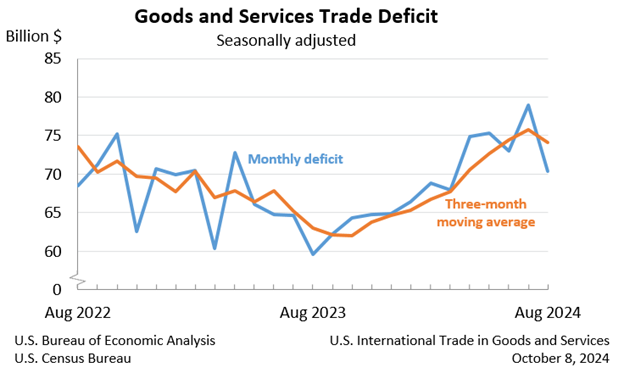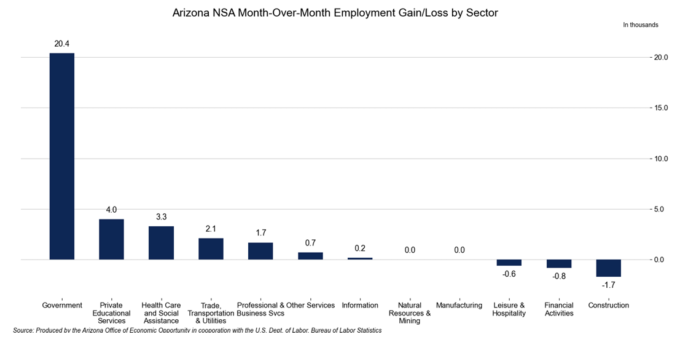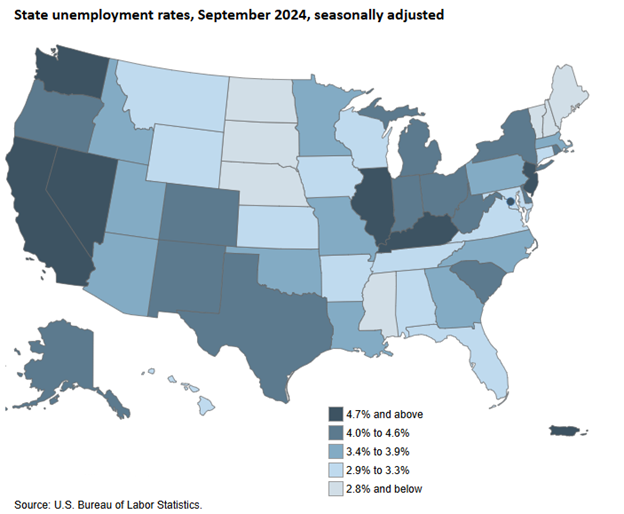EBRC Research Staff
Current data releases as of 25 October 2024
The Consumer Price Index increased 0.2% over the month in September, the same as it had for the prior two months. Shelter and food contributed most of the increase for September, while energy prices dropped 1.9%. The index for all items less food and energy increased 0.3% for the month. The annual inflation rate was 2.4% in September, the lowest since February 2021. Energy prices were down 6.8% over the year, while food increased 2.3%. The 12-month change in the index of all items less food and energy came in at 3.3%. –Valorie Rice
Use your cursor as a tooltip and click titles on/off in the legend at the bottom of the chart to make comparisons.
Producer prices were unchanged in September on a seasonally adjusted basis. Final demand goods were down 0.2% for the month, while final demand services rose 0.2%. The drop in final demand goods was primarily due to energy prices lowering by 2.7% for the month. The unadjusted 12-month change in the Producer Price Index for September was 1.8%, slightly lower than 1.9% reported for August. –Valorie Rice
The August goods and services trade deficit came in at $70.4 billion, down $8.5 billion from a revised $78.9 billion in July. August exports rose $5.3 billion to $271.8 billion, and imports fell $3.2 billion to $342.2 billion. The decrease in the deficit reflects a reduction in the goods deficit of $8.4 billion to $94.9 billion and an increase in the services surplus of $0.1 billion to $24.4 billion. Year to date, the goods and services deficit increased $47.1 billion, or 8.9% from the same period in 2023, with exports and imports rising 3.9% and 4.9%, respectively. The largest surpluses, in billions, occurred with the Netherlands ($5.5), South and Central America ($4.0), and Australia ($1.9), while the greatest deficits were with China ($24.7), the European Union ($19.1), and Mexico ($14.3). –Delaney O’Kray-Murphy

Total nonfarm employment in Arizona increased by 65,900 jobs over the year in September, with the seasonally adjusted unemployment rate increasing to 3.5% from 3.4% in August. The U.S. seasonally adjusted unemployment rate decreased 0.1 percentage points to 4.1% in September. Arizona non-seasonally adjusted total nonfarm employment increased by 29,300 in September, better than the pre-pandemic average of 28,800. Employment gains were reported in government (20,400); private educational services (4,000); health care and social assistance (3,300); trade, transportation, & utilities (2,100); professional & business services (1,700); other services (700); and information (200). Employment losses were reported in construction (-1,700), financial activities (-800), and leisure & hospitality (-600). No net changes were reported in natural resources & mining or manufacturing. –Delaney O’Kray-Murphy

There were 23 states with unemployment rates lower than the U.S. figure of 4.1% in September, Arizona being one of them with a seasonally adjusted rate of 3.5%. The U.S. Bureau of Labor Statistics state employment report indicated that South Dakota had the lowest jobless rate for the month, at 2.0%. Nevada had the highest unemployment rate in September, at 5.6%. Six states saw decreased unemployment rates compared to the same month last year, with Arizona showing one of the largest over-the-year rate decreases, moving down 0.7 percentage points. Arizona was one of five states with seasonally adjusted nonfarm payroll employment increases for September (Arizona, Colorado, Idaho, New Jersey, and Rhode Island). –Valorie Rice

According to the October 17th State Job Openings and Labor Turnover (JOLTS) report, the job openings rates decreased in two states, increased in six states, and were little changed in the rest. The job openings rates for Arizona were 5.6% for August, 5.1% for July, and 5.6% for June. The number of job openings decreased in two states, increased in 11 states, and was little changed in all other states. The largest decreases in job openings were in Illinois (-42,000) and Colorado (-26,000). The largest increase was in Texas (+69,000). Hire rates increased in one state, Florida, decreased in six states, and changed little in all other states. Arizona and Michigan saw the largest decreases, at -1.1 percentage points each. The hire rate for Arizona was lower in August than in the last two months, with 3.3% for August, 4.4% for July, and 3.9% for June. The number of hires decreased in six states, increased in one state, and was little changed in all others. The largest decreases were in Illinois (-65,000), Michigan (-50,000), and Arizona (-34,000). The number of layoffs and discharges decreased in seven states, increased in three states, and were little changed in the rest. Arizona was among the states with the highest level of decreased layoffs and discharges for August, at -15,000. Nationally, the layoff and discharge rate and the number of layoffs and discharges were little changed. –Alex Jaeger
In September, Arizona over the year total building permits saw a sizeable 23.8% decrease to 4,413, not seasonally adjusted. The number of single-family permits conversely saw a 13.1% increase over the year to 3,547. The Phoenix metro area contained most of the permits in the state with 3,454, a 27.4% decrease since last September. Similarly, the number of permits in Tucson declined 20.0% to 356. For counties, Graham, La Paz, Mohave, Navajo, and Yavapai had increases, while Apache, Cochise, Coconino, Gila, Maricopa, Pinal, Santa Cruz, and Yuma all saw decreases. –Delaney O’Kray-Murphy





